Table of contents
- Screwdriver tip on valve control Keep an eye on weak points
- Types of valve control
- Advantages and disadvantages of the timing belt
- Timing chain
- Timing chain tensioner / slide rails
- Example 2 – Honda NTV 650
- Example 3 – Ducati Monster 600 SS
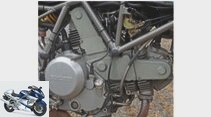
Ralf Petersen
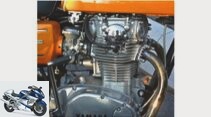



15th pictures

Ralf Petersen
1/15
The valve train controls the gas exchange in a four-stroke engine with the help of the inlet and outlet valves. Different designs are used depending on the type of motorcycle.
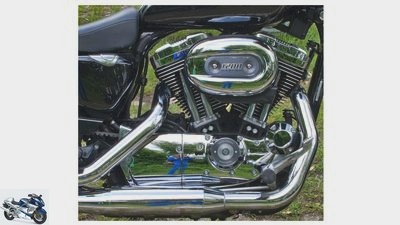
Ralf Petersen
2/15
Classic engine construction: ohv engine (ohv = overhead valves) from Harley-Davidson. The tulle pipes are clearly visible.
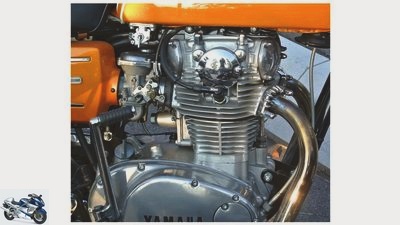
Ralf Petersen
3/15
Simplest and cheapest variant: ohc valve train with an overhead camshaft (ohc = overhead camshaft).

Ralf Petersen
4/15
Not a feast for the eyes and maintenance-intensive: on many Ducatis the valve train is controlled by a toothed belt.
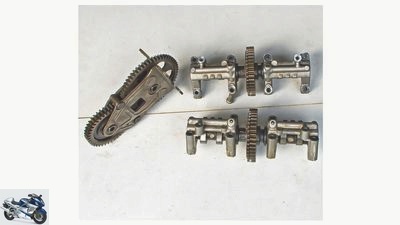
Ralf Petersen
5/15
Complex, but maintenance-free and almost indestructible: spur gear drive in the engine of a Honda VFR.
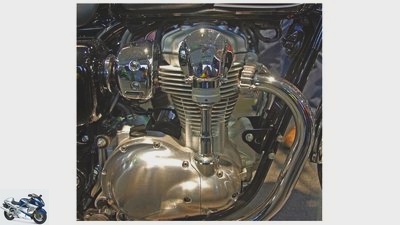
Ralf Petersen
6/15
Not only beautiful, but also durable and maintenance-free: the vertical shaft, here on a Kawasaki W 800.
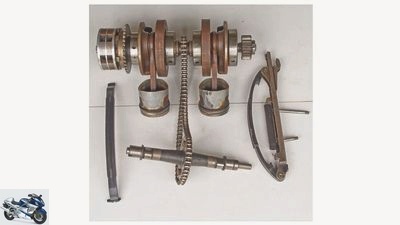
Ralf Petersen
7/15
Sprocket centered on the crankshaft and camshaft, roller chain and combination of spring-loaded chain tensioner and slide rail.
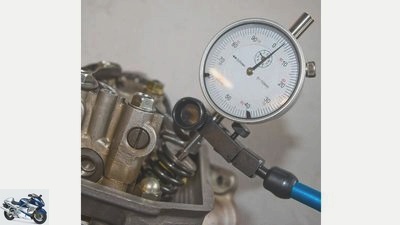
Ralf Petersen
8/15
Control is better: whether the timing is still correct can be checked with the aid of a dial gauge, if necessary.
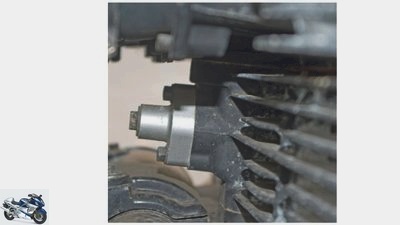
Ralf Petersen
9/15
Maintenance-friendly: If the external chain tensioner is located at the rear of the cylinder block, it can be replaced relatively easily.
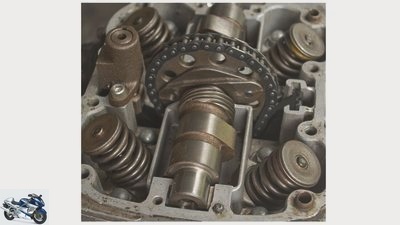
Ralf Petersen
10/15
Clear and easy to change: external tensioner and slide rails in the cylinder head of a Yamaha XS 360.
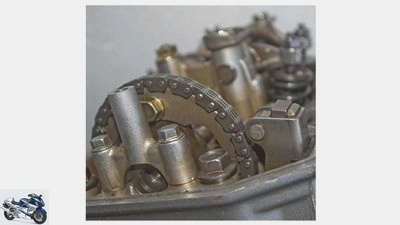
Ralf Petersen
11/15
Robust and durable: The Honda NTV 650 relies on a solid tooth chain for the valve train.

Ralf Petersen
12/15
Measurable: wear indicators on the timing chain tensioner on Honda V engines show the condition of the tensioning system.
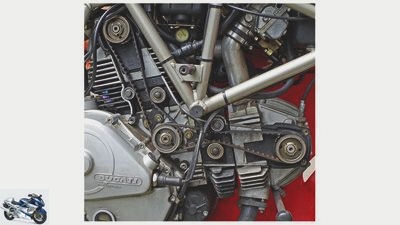
Ralf Petersen
13/15
Removing the timing belt on the Ducati is simple, but setting the correct tension has to be learned.
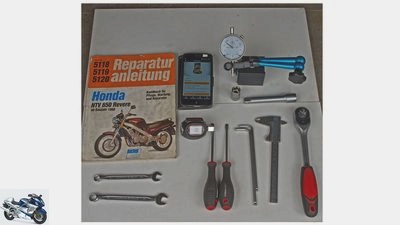
Ralf Petersen
14/15
In addition to suitable tools, you usually need the following for dismantling: seals, workshop manual, dial gauge, graduated disk, calliper, torque wrench, smartphone plus app.
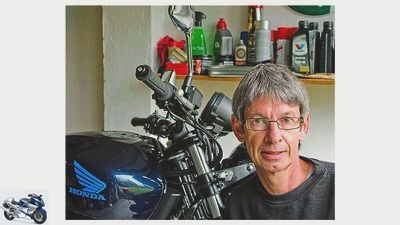
Ralf Petersen
15/15
Ralf Petersen works as a further education teacher at the VHS Duisburg and has been organizing mechanics courses for 22 years. 12 to 15 practical seminars on maintenance, repair and technology are offered every year. www.motorrad-schrauberkurse.de
counselor
workshop
Screwdriver tip on the subject of valve control
Screwdriver tip on valve control
Keep an eye on weak points
The valve train controls the gas exchange in a four-stroke engine with the aid of the inlet and outlet valves. Depending on the type of motorcycle, different designs are used, all of which have their advantages and disadvantages. As a rule, the valve train is low-maintenance, but you should take a look at the corresponding components when you get the chance and – if installed – keep an eye on weak points such as chain tensioners and toothed belts.
04/27/2021
Types of valve control
Normally, a valve is opened by a camshaft either directly, via a tappet, rocker arm or rocker arm and then closed again by a spring. This camshaft is driven by the crankshaft with a ratio of 2: 1, so the camshaft runs at half the speed of the crankshaft. In engines with the so-called ohv valve control (ohv = overhead valves), which has been common for a long time, the valves are controlled by an underlying camshaft via relatively long push rods and rocker arms in the cylinder head. Due to their inertia, these components stand in the way of high speeds and can therefore only be found in a few engines (e.g. Harley) today. The advantage of this design is that there are actually no wearing parts. At most, the rubber seals of the bumper grommet tubes can harden and become leaky. In engines with ohc valve control (ohc = overhead camshaft; overhead camshaft), on the other hand, the camshaft is located in the cylinder head and is usually driven by a chain or toothed belt, the valves are controlled by rocker arms. This design enables higher speeds and, above all, is simple and inexpensive to manufacture. dohc engines (dohc = double overhead camshaft; double overhead camshaft) even have two camshafts per cylinder head, one of which operates the intake valves and the other operates the exhaust valves, usually using rocker arms or bucket tappets. Even higher speeds are possible, and it is now standard in modern engine construction.
There are various options for transmitting the rotational movement from the crankshaft to the camshaft. Camshafts below are often driven by a toothed wheel, more rarely by a chain, while overhead camshafts are driven either by a vertical shaft, gear cascades, a timing chain or a toothed belt. Both the timing chains / toothed belts and their tensioning mechanism can cause problems.
Advantages and disadvantages of the timing belt
In contrast to the automotive industry, only a few motorcycle manufacturers (e.g. Ducati) use toothed belts to drive the camshafts. A toothed belt is usually made of plastic with reinforcing inserts and impresses with its smoothness, but it must be changed regularly. In addition, due to its width and its own, oil-free housing, it requires more space than timing chains. In the case of in-line engines, this has an unfavorable effect on the overall width. Spur gear drives with overhead camshafts (e.g. Honda V4 engines) are more complex, significantly more expensive and therefore very rare. They are completely maintenance-free and very durable, but the many interlocking, straight-toothed gears generate high levels of running noise. Honda therefore uses split gears that are braced against each other via springs (so-called zero backlash gears). Another complex, but also maintenance-free method of camshaft drive is the vertical shaft. With the help of two pairs of bevel gears, a deflection of 90 degrees is achieved on the crankshaft and camshaft. The crankshaft drives the upright shaft via a bevel drive, and this drives the camshaft via another bevel drive. Visually a feast for the eyes, it is unfortunately only rarely used because of the high costs.
Timing chain
Most modern motorcycle engines with an overhead camshaft (as well as some with a camshaft underhead) are driven by a timing chain. They are available as single or duplex roller chains or as quieter inverted tooth chains. So that the intake and exhaust valves of the engine are opened and closed in exactly the right order, the timing chain transfers the power from a sprocket / gear, which is flanged directly to or on the crankshaft, to the sprocket of the camshaft. The sometimes quite long timing chain must run as tightly as possible. Therefore, a chain tensioner and plastic guide rails, the so-called slide rails, are required to prevent vibrations. These components of the clamping mechanism are relatively durable, but ultimately wear parts that have to be replaced in case of doubt. If the tensioning mechanism fails, the chain can, in extreme cases, skip, resulting in major engine damage. Most of the time, however, a defect is announced in good time by a stronger noise development. This so-called timing chain rattle occurs particularly when the gas is removed and the vehicle is in push mode. Often times it can be eliminated by adjusting or replacing the timing chain tensioner.
But timing chain wear also causes problems. As the rollers and chain links wear out, the timing chain inevitably becomes longer. This changes the timing and the engine no longer runs optimally. Interestingly, even small deviations lead to a performance curve that is significantly worse than with correct timing. With the help of precise instructions, a degree disk and a dial gauge, the timing can be checked if necessary. However, this is more of an activity for experienced screwdrivers. If the timing chain is badly worn, which normally only occurs at high mileage, a change is inevitable. If the chain is in the middle of the crankshaft, this can be very complex and require the engine to be completely dismantled. An alternative might be timing chains with rivet chain lock from the accessories.
Timing chain tensioner / slide rails
Most motorcycles have an automatic tensioner that works either with a spring system, hydraulically via oil pressure, or a combination of both types. There are also models that require regular checks or manual retensioning (e.g. Honda CB 500 Four). Conveniently, some tensioners also have some kind of wear indicator that shows whether a replacement is required. In numerous posts in forums one can read again and again about noticeable noise development of the engines, for which there can be various reasons. A defective or worn tensioner can (as for example in the current endurance test of the Honda Fireblade), but does not necessarily have to be the cause. If in doubt, it should be removed, checked and, if necessary, replaced. If it sits on the back of the cylinder block, this is usually relatively easy. It is then often only held by two screws and can be easily dismantled. If, however, a combination of tensioner and slide rail is involved, at least the cylinder head cover, sometimes even the cylinder head, must usually be removed for dismantling. The slide rails, which are usually made of plastic, can also cause problems due to wear and tear or hardening of the material and, in the worst case, even crumble. An indication of this are plastic residues in the oil. Run-in or damaged slide rails must be replaced in any case. The effort required for this is very different depending on the design.
Example 1 – Yamaha XS 360
In the simply constructed XS engine, the valve train is exposed after removing the cylinder head cover and can be easily checked for visible damage. The separate chain tensioner presses on one of the slide rails (the other is rigid) and works with a spring system and locking steps. Depending on the elongation of the chain, the piston is pushed further forward and engages in the next toothing. To change the chain tensioner and slide rails, only the tensioner held by two screws has to be removed. Then both slide rails can be easily removed. To change the timing chain (a simple roller chain) with an endless chain, the motor would have to be dismantled or a timing chain with a riveted chain lock would have to be used. The biggest problem with this old engine is getting spare parts. The required original parts are no longer officially available from Yamaha.
Example 2 – Honda NTV 650
As with the XS, the valve train is exposed after removing the cylinder head cover. The camshaft is driven by a solid and powerfully dimensioned tooth chain, which promises a long service life. The spring-loaded timing chain tensioner is self-adjusting. The state of wear can be read off a wedge without any problems. The further this wedge protrudes, the more worn the tensioner and chain are. This timing chain tensioner projection can be measured with the aid of a caliper. The value I measured is 4.3 mm at the front and 4.5 mm at the rear, despite the very high mileage, and underlines the quality of this construction. From 7 mm, the chain and tensioner should be changed. However, this is a rather complex engine repair including cylinder head dismantling. For the spare parts alone (timing chain, chain tensioner, slide rail, etc.), around 800 euros are due. Since it is a V-engine, two chains and tensioning systems are of course required. If only the tensioner is defective, it will be considerably cheaper. It can be removed relatively easily without dismantling the cylinder head and costs a comparatively modest 130 euros.
Example 3 – Ducati Monster 600 SS
As with most Ducatis, the Monster’s valve train is controlled by a toothed belt, which ages and can tear due to embrittlement. That is why there is a specified interval for the exchange (depending on the model, e.g. every two years or 10,000 / 20,000 km). The price for this change in a specialist workshop is around 400 euros. Since the toothed belt is easily accessible after removing the toothed belt covers, experienced screwdrivers (!) May be able to do this themselves.
material costs
The material costs are around 50 to 70 euros. After removing the old toothed belt, check the tensioning pulleys and mount the new belts, carefully observing the markings on the pulleys, motor housing and so on. The biggest challenge is setting the correct tension. There are various tricks for this, such as a suitable spring balance or a measuring device that measures the vibration frequency of the toothed belt. This is now even possible with a smartphone and a suitable app. Corresponding instructions and tips can be found in the usual online forums.
Related articles
-
Yamaha counselor technology & future Valve control gas exchange PS technology series part 2 Valve control and gas exchange Content of Almost exactly four…
-
Suzuki patent: Variable valve control 2.0
Suzuki 8th pictures Suzuki 1/8 Suzuki is working on a new variable valve control. Suzuki 2/8 It should serve the inlet and outlet and be hydraulically…
-
Adjust the valve clearance on the BMW boxer
Schermer counselor workshop Adjust the valve clearance on the BMW boxer Screwdriver tip Adjust the valve clearance on the BMW boxer Thanks to the exposed…
-
Workshop – screwdriver tip for the inspection
Ralf Petersen 15th pictures Ralf Petersen 1/15 Every motorcycle must be serviced regularly if it is to function properly. Ralf Petersen 2/15 What is…
-
Ducati 10 pictures Ducati 1/10 …compact, rotatable hydraulic units on each camshaft, variable timing. The pulse generators for the position of the…
-
Technology development in valve actuation
factstudio.de 23 pictures Katrin Sdun 1/23 Before valve actuation via rocker arms prevailed, numerous other designs determined the state of the art. Ralf…
-
MotoGP technology: valve trains
counselor workshop MotoGP technology: valve trains MotoGP technology: valve trains Sex offender Stoner? Traction control? Tire technology? Happiness? It…
-
MOTORCYCLE screwdriver tip on starting problems
Ralf Petersen 19th pictures Ralf Petersen 1/19 Starting problems on the motorcycle are tricky. They can occur without warning, whether the engine is cold…
-
Screwdriver tip: retreading wheels
Ralf Petersen 15th pictures Suzuki 1/15 So that everything runs smoothly. The screwdriver tip for everything to do with bikes. Ralf Petersen 2/15 What…
-
Screwdriver tip oil change and oil level check
Photo: mps photo studio 14th pictures Honda 1/14 Screwdriver tip – oil change and oil level check. Ralf Petersen 2/14 Preparation: All of this is needed….